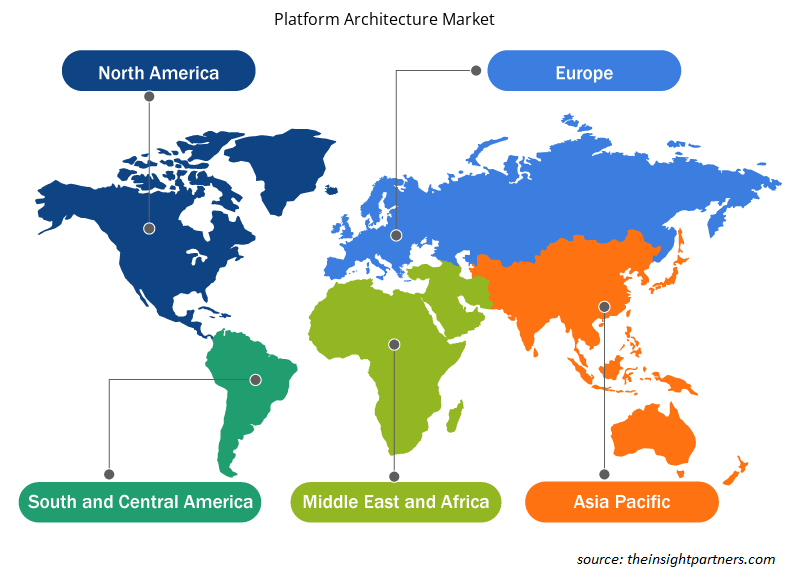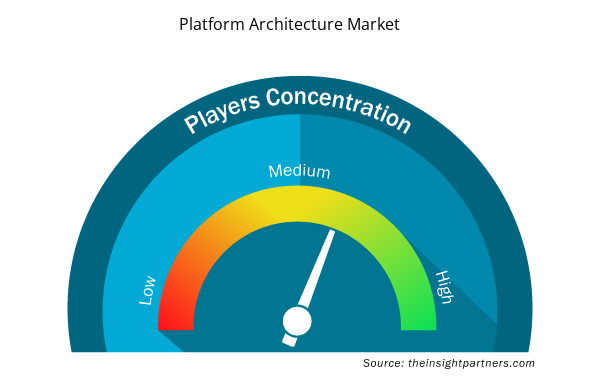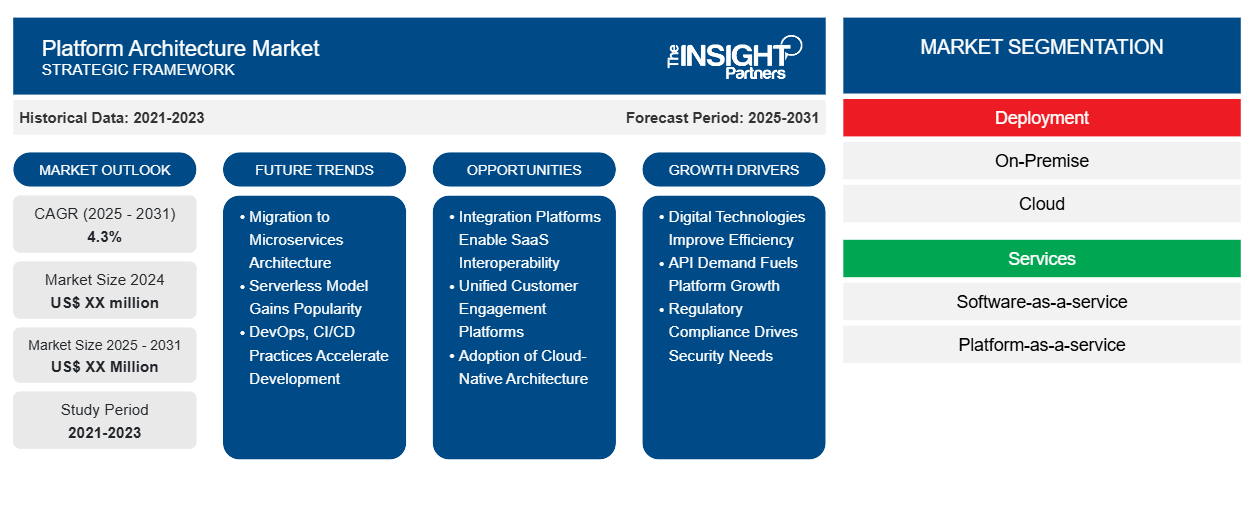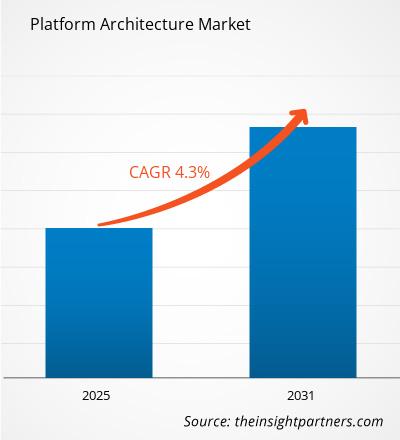Es wird erwartet, dass der Markt für Plattformarchitektur von 2023 bis 2031 eine durchschnittliche jährliche Wachstumsrate (CAGR) von 4,3 % verzeichnet, wobei die Marktgröße von XX Millionen US-Dollar im Jahr 2023 auf XX Millionen US-Dollar im Jahr 2031 wächst.CAGR of 4.3% from 2023 to 2031, with a market size expanding from US$ XX million in 2023 to US$ XX Million by 2031.
Der Bericht zum Plattformarchitekturmarkt umfasst Analysen nach Bereitstellung, Diensten, Endbenutzer und Geografie. Die globale Analyse wird weiter auf regionaler Ebene und in den wichtigsten Ländern aufgeschlüsselt.
Zweck des Berichts
Der Bericht „Plattformarchitekturmarkt“ von The Insight Partners zielt darauf ab, die gegenwärtige Landschaft und das zukünftige Wachstum sowie die wichtigsten treibenden Faktoren, Herausforderungen und Chancen zu beschreiben. Dies wird verschiedenen Geschäftspartnern Einblicke geben, wie zum Beispiel:
- Technologieanbieter/-hersteller: Um die sich entwickelnde Marktdynamik zu verstehen und die potenziellen Wachstumschancen zu kennen, damit sie fundierte strategische Entscheidungen treffen können.
- Investoren: Durchführung einer umfassenden Trendanalyse hinsichtlich der Marktwachstumsrate, der finanziellen Marktprognosen und der Chancen entlang der Wertschöpfungskette.
- Regulierungsbehörden: Zur Regulierung von Richtlinien und Überwachungsaktivitäten auf dem Markt mit dem Ziel, Missbrauch zu minimieren, das Vertrauen der Anleger zu bewahren und die Integrität und Stabilität des Marktes aufrechtzuerhalten.
Plattformarchitektur Marktsegmentierung
Einsatz
- Vor Ort
- Wolke
Dienstleistungen
- Software-as-a-Service
- Plattform als Service
Endbenutzer
- BFSI
- Regierung
- IT und Telekommunikation
- Herstellung
- Einzelhandel
- Sonstiges
Geographie
- Nordamerika
- Europa
- Asien-Pazifik
- Süd- und Mittelamerika
- Naher Osten und Afrika
Geographie
- Nordamerika
- Europa
- Asien-Pazifik
- Süd- und Mittelamerika
- Naher Osten und Afrika
Passen Sie diesen Bericht Ihren Anforderungen an
Sie erhalten kostenlos individuelle Anpassungen an jedem Bericht, einschließlich Teilen dieses Berichts oder einer Analyse auf Länderebene, eines Excel-Datenpakets sowie tolle Angebote und Rabatte für Start-ups und Universitäten.
- Holen Sie sich die wichtigsten Markttrends aus diesem Bericht.Dieses KOSTENLOSE Beispiel umfasst eine Datenanalyse von Markttrends bis hin zu Schätzungen und Prognosen.
Wachstumstreiber auf dem Plattformarchitekturmarkt
- Digitale Technologien verbessern die Effizienz: Viele Unternehmen nutzen digitale Technologien, um die Effizienz und das Benutzererlebnis zu verbessern. Eine Plattformarchitektur verbindet mehrere digitale Lösungen, sodass sie effektiver interagieren. Da Daten besser ausgetauscht werden können und die betriebliche Agilität verbessert wird, setzen viele Unternehmen auf Plattformarchitekturen, um mehr Geschäfte zu geringeren Kosten und schneller abzuwickeln und so die Markteinführungszeit für neue Produkte und Dienstleistungen zu verkürzen. Die Nachfrage nach einer robusten Plattformarchitektur wird also durch das Bedürfnis eines Unternehmens getrieben, Prozesse zu rationalisieren, bessere Entscheidungen zu treffen und gemeinsam neue Lösungen zu entwickeln.
- API-Nachfrage treibt Plattformwachstum an: Die wachsende Nachfrage nach Anwendungsprogrammierschnittstellen (API) treibt diesen Trend an, da immer mehr Unternehmen danach streben, ihre Anwendungen und Dienste interoperabel zu machen oder beides aus externen Quellen über APIs effektiver zu integrieren (und das ist nichts anderes als eine API – eine Schnittstelle zwischen einer Anwendung und einer anderen, damit diese besser miteinander kommunizieren können und so eine weitaus bessere Benutzererfahrung und Betriebseffizienz bieten). Da Unternehmen zunehmend auf die Einführung von Microservices-Architekturen und agilen Entwicklungsmethoden setzen, benötigen sie auch weitaus ausgefeiltere API-Verwaltungsrichtlinien und -systeme. Infolgedessen wird die Plattformarchitektur immer weiter verbreitet, da immer mehr Unternehmen APIs verwenden, um ihre Produkte und Lösungen skalierbar zu erstellen.
- Die Einhaltung gesetzlicher Vorschriften erhöht den Sicherheitsbedarf: Die Vorschriften werden mit jedem neuen Gesetzentwurf strenger. Daher bauen Unternehmen der neuen Generation ihre Plattformarchitekturen so auf, dass sie den Sicherheitsanforderungen und -vorschriften des Marktes entsprechen. Dies erfordert mehr Investitionen in die Sicherheitsfunktionen der Plattformarchitekturen, wie z. B. robuste Sicherheitsmechanismen, Identitätsmanagement, Zugriffsverwaltung und Datenverwaltung. Angesichts strenger regulatorischer Anforderungen auf den Märkten müssen Kanalkunden strenge Sicherheitsvorkehrungen treffen und die Compliance-Anforderungen erfüllen. Angesichts der sich entwickelnden regulatorischen Landschaft werden Unternehmen zunehmend Plattformangebote benötigen, um ihre Sicherheitslage zu verbessern und die Compliance zu unterstützen, was sich auf das Marktwachstum auswirken wird.
Zukünftige Trends auf dem Plattformarchitekturmarkt
- Migration zur Microservices-Architektur: Unternehmen migrieren von monolithischen Systemen zu einer Microservices-Architektur: Sie hilft ihnen, effizient und unabhängig zu skalieren, sie kann Flexibilität und Geschwindigkeit verbessern und erfordert nicht, dass Teams immer eine zentrale Befehlsstelle zum Bereitstellen oder Skalieren verwenden; stattdessen können sie dies selbst tun. So profitieren sie von einer effizienteren Nutzung von Ressourcen, der Integration verschiedener Technologien und der Fähigkeit, kontinuierliche Innovationen im heutigen wettbewerbsorientierten digitalen Umfeld zu unterstützen. Mit anderen Worten: Mit der Weiterentwicklung cloudnativer Technologien werden Microservices zur Norm für moderne Anwendungen.
- Serverloses Modell wird immer beliebter: Das aufstrebende serverlose Modell, bei dem Programmierer ihre Apps schreiben, ohne Server zu verwalten, setzt sich bereits durch. Die automatische Skalierung von Anwendungen basierend auf der Last führt zu einer besseren Ressourcenauslastung als physisch oder virtuell verwaltete Server und kann zu einer verbesserten Kosteneffizienz führen. Tatsächlich haben Unternehmen aller Größen kürzlich serverlose Workloads wie analytische Unternehmensdatenbanken oder ganze ereignisgesteuerte Anwendungen verlagert, um von schnelleren Zykluszeiten zu profitieren und den Aufwand für die traditionelle Infrastrukturverwaltung zu reduzieren. Wir erwarten, dass sich dieser Trend beschleunigen wird, da Cloud-Service-Anbieter ihre serverlosen Portfolios erweitern und Unternehmen mehr Hilfe bei der Migration von Workloads auf dieses Modell bieten. Insgesamt wird dieser serverlose Trend die Geschwindigkeit und Ressourcenauslastung für Experimente und Entwicklung im gesamten Unternehmens-Stack verbessern
- DevOps, CI/CD-Praktiken beschleunigen die Entwicklung: DevOps hat sich als Überbegriff herausgebildet, der die Veränderung der Plattformarchitektur widerspiegelt, die sich aus der Kombination der Continuous Integration/Continuous Deployment (CI/CD)-Praktiken mit der weit verbreiteten Einführung agiler Entwicklungsmethoden ergibt, wodurch Konflikte und Übergaben zwischen Entwicklern und Betreibern minimiert werden.
Wenn Tests und Bereitstellungen automatisiert werden, ist es weniger wahrscheinlich, dass Fehler von einer Phase zur nächsten durchrutschen, was zu schnellerer Softwarequalität führt. Je mehr Unternehmen agile Methoden anwenden, desto mehr werden DevOps- und CI/CD-Praktiken in den Vordergrund rücken und die Geschwindigkeit der Funktionsbereitstellung für Kunden verbessern.
Marktchancen für Plattformarchitekturen
- Integrationsplattformen ermöglichen SaaS-Interoperabilität: Kunden mit immer mehr SaaS-Anwendungen benötigen Middleware oder Integrationsplattformen, damit die Daten reibungslos zwischen verschiedenen Anwendungen kommunizieren können. Unternehmen müssen nicht mehr Anwendungen oder Dienste entwickeln, sondern nur einen reibungslosen Datenaustausch und die Interoperabilität zwischen verschiedenen SaaS-Anwendungen.
- Vereinheitlichte Plattformen für die Kundeneinbindung: Die wachsende Nachfrage nach vereinheitlichten Plattformen für die Kundeneinbindung, insbesondere von Unternehmen, die bereits digitalisiert sind, das Erlebnis ihrer Kunden und Endnutzer aber verbessern oder differenzieren möchten, schafft Chancen für Anbieter digitaler Erlebnisplattformen, die Architekturen anbieten, die Business-Content-Management, Analysen, Web- und mobile Benutzererlebnisse sowie Engagement-Punkte kombinieren.
- Einführung von Cloud-nativer Architektur: Eine der wichtigsten Chancen auf dem Markt für Plattformarchitektur ist die Cloud-native Architektur. Die Umstellung der meisten Unternehmen auf die Cloud, die eine größere Skalierbarkeit und Flexibilität bei geringeren Kosten bietet, führt zu einer steigenden Nachfrage nach optimierten Plattformarchitekturen für Cloud-Umgebungen. Cloud-native Plattformen, die auf Mikrodiensten, Containern und APIs basieren, ermöglichen es Unternehmen, Anwendungen und Dienste schneller und kostengünstiger zu entwickeln, als dies mit einer herkömmlichen monolithischen Architektur möglich ist. Die wichtigsten Treiber dieser Umstellung sind Agilität bei Entwicklung und Bereitstellung sowie die bedarfsgerechte Skalierung von Ressourcen. Aus Sicht der Anbieter von Plattformarchitektur bietet dieser Trend eine enorme Chance, Lösungen bereitzustellen, die Unternehmen bei ihrer digitalen Transformation unterstützen. Ein weiterer Vorteil, den Cloud-native Plattformen bieten, ist eine zuverlässigere Umgebung, einschließlich besserer Notfallwiederherstellung, automatischer Skalierung und besserer Leistungsüberwachung. Daher wird ein Aufwärtstrend bestehen bleiben, da Unternehmen zunehmend digitale Strategien einführen, die die Implementierung von Cloud-nativen Plattformarchitekturlösungen erfordern und neue Türen für Innovation und Marktwachstum bieten.
Regionale Einblicke in den Plattformarchitekturmarkt
Die regionalen Trends und Faktoren, die den Plattformarchitekturmarkt während des Prognosezeitraums beeinflussen, wurden von den Analysten von Insight Partners ausführlich erläutert. In diesem Abschnitt werden auch die Marktsegmente und die Geografie von Plattformarchitektur in Nordamerika, Europa, im asiatisch-pazifischen Raum, im Nahen Osten und Afrika sowie in Süd- und Mittelamerika erörtert.

- Erhalten Sie regionale Daten zum Plattformarchitekturmarkt
Umfang des Marktberichts zur Plattformarchitektur
| Berichtsattribut | Details |
|---|---|
| Marktgröße im Jahr 2023 | XX Millionen US-Dollar |
| Marktgröße bis 2031 | XX Millionen US-Dollar |
| Globale CAGR (2023 - 2031) | 4,3 % |
| Historische Daten | 2021-2022 |
| Prognosezeitraum | 2024–2031 |
| Abgedeckte Segmente | Nach Bereitstellung
|
| Abgedeckte Regionen und Länder | Nordamerika
|
| Marktführer und wichtige Unternehmensprofile |
|
Dichte der Marktteilnehmer im Bereich Plattformarchitektur: Die Auswirkungen auf die Geschäftsdynamik verstehen
Der Markt für Plattformarchitektur wächst rasant, angetrieben durch die steigende Nachfrage der Endnutzer aufgrund von Faktoren wie sich entwickelnden Verbraucherpräferenzen, technologischen Fortschritten und einem größeren Bewusstsein für die Vorteile des Produkts. Mit steigender Nachfrage erweitern Unternehmen ihr Angebot, entwickeln Innovationen, um die Bedürfnisse der Verbraucher zu erfüllen, und nutzen neue Trends, was das Marktwachstum weiter ankurbelt.
Die Marktteilnehmerdichte bezieht sich auf die Verteilung der Firmen oder Unternehmen, die in einem bestimmten Markt oder einer bestimmten Branche tätig sind. Sie gibt an, wie viele Wettbewerber (Marktteilnehmer) in einem bestimmten Marktraum im Verhältnis zu seiner Größe oder seinem gesamten Marktwert präsent sind.
Die wichtigsten auf dem Markt für Plattformarchitektur tätigen Unternehmen sind:
- Apprenda Inc.
- Amazon Web Services
- Cisco Systems, Inc.
- Google LLC
- IBM Corp.
Haftungsausschluss : Die oben aufgeführten Unternehmen sind nicht in einer bestimmten Reihenfolge aufgeführt.

- Überblick über die wichtigsten Akteure auf dem Plattformarchitekturmarkt
Wichtige Verkaufsargumente
- Umfassende Abdeckung: Der Bericht deckt die Analyse von Produkten, Diensten, Typen und Endbenutzern des Plattformarchitektur-Marktes umfassend ab und bietet einen ganzheitlichen Überblick.
- Expertenanalyse: Der Bericht basiert auf dem umfassenden Verständnis von Branchenexperten und Analysten.
- Aktuelle Informationen: Der Bericht stellt durch die Abdeckung aktueller Informationen und Datentrends Geschäftsrelevanz sicher.
- Anpassungsoptionen: Dieser Bericht kann angepasst werden, um spezifische Kundenanforderungen zu erfüllen und die Geschäftsstrategien optimal anzupassen.
Der Forschungsbericht zum Plattformarchitekturmarkt kann daher dabei helfen, die Branchensituation und Wachstumsaussichten zu entschlüsseln und zu verstehen. Obwohl es einige berechtigte Bedenken geben kann, überwiegen die allgemeinen Vorteile dieses Berichts tendenziell die Nachteile.
- Historische Analyse (2 Jahre), Basisjahr, Prognose (7 Jahre) mit CAGR
- PEST- und SWOT-Analyse
- Marktgröße Wert/Volumen – Global, Regional, Land
- Branche und Wettbewerbsumfeld
- Excel-Datensatz


- Aerosol Paints Market
- Saudi Arabia Drywall Panels Market
- UV Curing System Market
- Machine Condition Monitoring Market
- Medical Enzyme Technology Market
- Small Internal Combustion Engine Market
- Excimer & Femtosecond Ophthalmic Lasers Market
- Wind Turbine Composites Market
- Small Molecule Drug Discovery Market
- Mesotherapy Market

Report Coverage
Revenue forecast, Company Analysis, Industry landscape, Growth factors, and Trends

Segment Covered
This text is related
to segments covered.

Regional Scope
North America, Europe, Asia Pacific, Middle East & Africa, South & Central America

Country Scope
This text is related
to country scope.
Häufig gestellte Fragen
Some of the customization options available based on request are additional 3-5 company profiles and country-specific analysis of 3-5 countries of your choice. Customizations are to be requested/discussed before making final order confirmation, as our team would review the same and check the feasibility.
The report can be delivered in PDF/PPT format; we can also share excel dataset based on the request.
Key companies of this market are: Axxon Soft, CNL Software, Genetec Inc, Intergraph Corporation Hexagon AB, Milestone systems A S, Prysm Software, Qognify, Tyco International Plc Johnson Controls, Verint Systems Inc.
The Platform Architecture Market is expected to register a CAGR of 4.3% from 2023-2031.
Key future trends in this market are - Centralized security management systems, Integration with IoT devices, AI-driven threat detection
The major factors impacting the Platform Architecture Market are: Regulatory Compliance and Security, Digital Transformation, and Increased Demand for APIs
Trends and growth analysis reports related to Technology, Media and Telecommunications : READ MORE..
1. Apprenda Inc.
2. Amazon Web Services
3. Cisco Systems, Inc.
4. Google LLC
5. IBM Corp.
6. Microsoft Corp.
7. Oracle Corporation
8. RNF technologies
9. SAP SE
10. Synopsys Inc.
The Insight Partners performs research in 4 major stages: Data Collection & Secondary Research, Primary Research, Data Analysis and Data Triangulation & Final Review.
- Data Collection and Secondary Research:
As a market research and consulting firm operating from a decade, we have published and advised several client across the globe. First step for any study will start with an assessment of currently available data and insights from existing reports. Further, historical and current market information is collected from Investor Presentations, Annual Reports, SEC Filings, etc., and other information related to company’s performance and market positioning are gathered from Paid Databases (Factiva, Hoovers, and Reuters) and various other publications available in public domain.
Several associations trade associates, technical forums, institutes, societies and organization are accessed to gain technical as well as market related insights through their publications such as research papers, blogs and press releases related to the studies are referred to get cues about the market. Further, white papers, journals, magazines, and other news articles published in last 3 years are scrutinized and analyzed to understand the current market trends.
- Primary Research:
The primarily interview analysis comprise of data obtained from industry participants interview and answers to survey questions gathered by in-house primary team.
For primary research, interviews are conducted with industry experts/CEOs/Marketing Managers/VPs/Subject Matter Experts from both demand and supply side to get a 360-degree view of the market. The primary team conducts several interviews based on the complexity of the markets to understand the various market trends and dynamics which makes research more credible and precise.
A typical research interview fulfils the following functions:
- Provides first-hand information on the market size, market trends, growth trends, competitive landscape, and outlook
- Validates and strengthens in-house secondary research findings
- Develops the analysis team’s expertise and market understanding
Primary research involves email interactions and telephone interviews for each market, category, segment, and sub-segment across geographies. The participants who typically take part in such a process include, but are not limited to:
- Industry participants: VPs, business development managers, market intelligence managers and national sales managers
- Outside experts: Valuation experts, research analysts and key opinion leaders specializing in the electronics and semiconductor industry.
Below is the breakup of our primary respondents by company, designation, and region:

Once we receive the confirmation from primary research sources or primary respondents, we finalize the base year market estimation and forecast the data as per the macroeconomic and microeconomic factors assessed during data collection.
- Data Analysis:
Once data is validated through both secondary as well as primary respondents, we finalize the market estimations by hypothesis formulation and factor analysis at regional and country level.
- Macro-Economic Factor Analysis:
We analyse macroeconomic indicators such the gross domestic product (GDP), increase in the demand for goods and services across industries, technological advancement, regional economic growth, governmental policies, the influence of COVID-19, PEST analysis, and other aspects. This analysis aids in setting benchmarks for various nations/regions and approximating market splits. Additionally, the general trend of the aforementioned components aid in determining the market's development possibilities.
- Country Level Data:
Various factors that are especially aligned to the country are taken into account to determine the market size for a certain area and country, including the presence of vendors, such as headquarters and offices, the country's GDP, demand patterns, and industry growth. To comprehend the market dynamics for the nation, a number of growth variables, inhibitors, application areas, and current market trends are researched. The aforementioned elements aid in determining the country's overall market's growth potential.
- Company Profile:
The “Table of Contents” is formulated by listing and analyzing more than 25 - 30 companies operating in the market ecosystem across geographies. However, we profile only 10 companies as a standard practice in our syndicate reports. These 10 companies comprise leading, emerging, and regional players. Nonetheless, our analysis is not restricted to the 10 listed companies, we also analyze other companies present in the market to develop a holistic view and understand the prevailing trends. The “Company Profiles” section in the report covers key facts, business description, products & services, financial information, SWOT analysis, and key developments. The financial information presented is extracted from the annual reports and official documents of the publicly listed companies. Upon collecting the information for the sections of respective companies, we verify them via various primary sources and then compile the data in respective company profiles. The company level information helps us in deriving the base number as well as in forecasting the market size.
- Developing Base Number:
Aggregation of sales statistics (2020-2022) and macro-economic factor, and other secondary and primary research insights are utilized to arrive at base number and related market shares for 2022. The data gaps are identified in this step and relevant market data is analyzed, collected from paid primary interviews or databases. On finalizing the base year market size, forecasts are developed on the basis of macro-economic, industry and market growth factors and company level analysis.
- Data Triangulation and Final Review:
The market findings and base year market size calculations are validated from supply as well as demand side. Demand side validations are based on macro-economic factor analysis and benchmarks for respective regions and countries. In case of supply side validations, revenues of major companies are estimated (in case not available) based on industry benchmark, approximate number of employees, product portfolio, and primary interviews revenues are gathered. Further revenue from target product/service segment is assessed to avoid overshooting of market statistics. In case of heavy deviations between supply and demand side values, all thes steps are repeated to achieve synchronization.
We follow an iterative model, wherein we share our research findings with Subject Matter Experts (SME’s) and Key Opinion Leaders (KOLs) until consensus view of the market is not formulated – this model negates any drastic deviation in the opinions of experts. Only validated and universally acceptable research findings are quoted in our reports.
We have important check points that we use to validate our research findings – which we call – data triangulation, where we validate the information, we generate from secondary sources with primary interviews and then we re-validate with our internal data bases and Subject matter experts. This comprehensive model enables us to deliver high quality, reliable data in shortest possible time.


 Holen Sie sich ein kostenloses Muster für diesen Bericht
Holen Sie sich ein kostenloses Muster für diesen Bericht